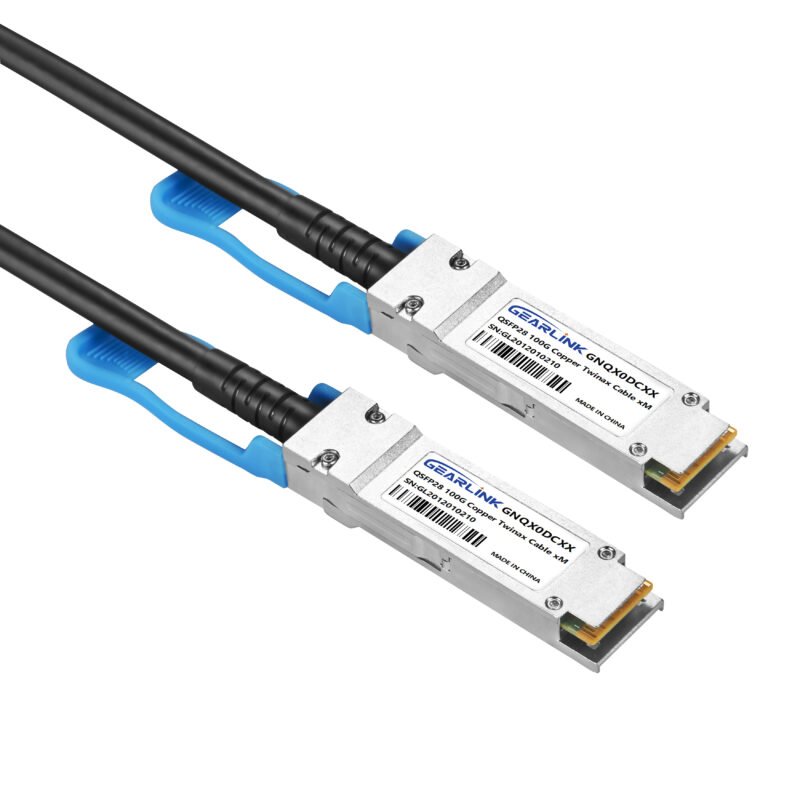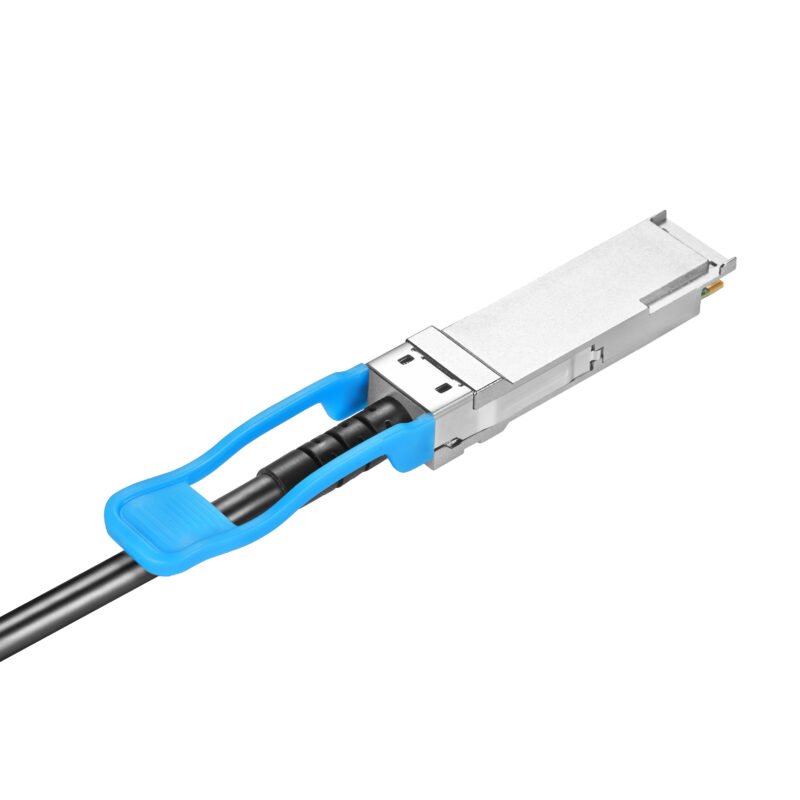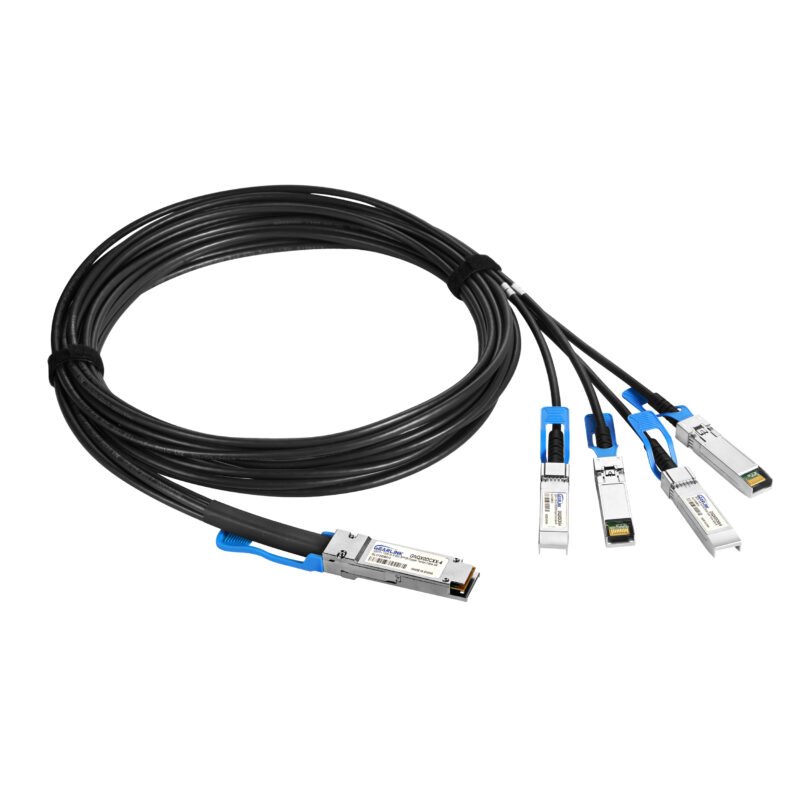100G QSFP28 to 4 x 25G SFP28 Passive Direct Attach Copper Breakout Cable
Achieve efficient 100 Gb/s connections with our twinax cable breakout DAC (QSFP28 to 4×25G SFP28). Durable, low-power, and budget-friendly. View product details now.
- Estimated Delivery : Up to 4 business days
- Free Shipping & Returns : On all orders over $200
The 100G QSFP28 to 4x25G SFP28 DAC Cable is a high-speed data transmission cable designed to split a single 100G QSFP28 port into four independent 25G SFP28 ports. It is primarily used for connecting network devices such as switches, servers, and storage equipment.
In high-density data centers, where numerous servers and network devices need interconnection, this cable efficiently utilizes device ports while providing high bandwidth and low-latency connections.
For network switching and aggregation, the cable enables multiple 25G SFP28 ports to be combined into a single, higher-bandwidth connection, making it ideal for setting up high-capacity network links.
In storage connectivity, the cable ensures fast, reliable connections to storage devices, offering the necessary bandwidth to handle heavy data traffic within data centers.
Overall, the 100G QSFP28 to 4x25G SFP28 DAC Cable is widely used in high-density data centers, network aggregation, and storage environments, providing fast, high-bandwidth, and reliable data transmission between devices.
- Overview of DAC High-Speed Cables
DAC (Direct Attach Cable) high-speed cables are modules with fixed connectors at both ends, commonly used for short-distance high-speed connections. DAC cables use copper wires to transmit electrical signals and do not involve optical-electrical conversion, meaning they do not require optical components. They are generally suitable for short-distance connections and stacking applications. DAC high-speed cables are widely used in data centers, high-performance computers, and large-capacity storage devices.
- Difference Between DAC High-Speed Cables and AOC Active Optical Cables
DAC high-speed cables and AOC active optical cables are both high-speed cables used for interconnecting devices or stacking them. Typically, DAC passive cables are chosen for short-distance device stacking, making DAC cables a type of stacking cable. For longer-distance device connections, AOC active optical cables are generally used, offering greater transmission distance and more stable performance.
There are notable differences between DAC and AOC cables. Firstly, DAC cables are direct-attach copper cables (like DAC passive cables), with a relatively short transmission distance. In contrast, AOC cables contain active components, such as optical-electrical converters, which enable them to support longer distances, reaching up to 100 meters or more. Secondly, regarding power consumption, DAC cables have very low power consumption due to the absence of active components, while AOC cables have some power consumption due to the active modules. Furthermore, in terms of cost, DAC cables are typically more affordable, whereas AOC cables are more expensive due to their technical complexity.
- What Type of Cable is Used for DAC High-Speed Cables? How Does It Differ from Ethernet Cables?
DAC high-speed cables typically use special copper cables, which are different from Ethernet cables. Ethernet cables primarily consist of copper twisted pairs that transmit data via electrical signals, with a shorter transmission distance (usually under 100 meters) and are more susceptible to electromagnetic interference. In contrast, the copper cables in DAC high-speed cables are designed for high-speed, high-bandwidth transmission. These cables have advantages such as faster transmission speed, higher bandwidth, and better resistance to electromagnetic interference. The maximum transmission distance for DAC cables is typically up to 7 meters.
- Categories of DAC High-Speed Cables
DAC high-speed cables are classified as follows, and the differences between these DAC cables can be clearly compared in the chart below:
10G SFP+ DAC|25G SFP28 DAC|40G QSFP+ DAC|100G QSFP28 DAC|QSFP+ 40G to 4x10G SFP+ DAC|QSFP28 100G to 4x25G SFP28 DAC|200G QSFP56 DAC
| Brand | WHGEARLINK |
|---|---|
| Description | QSFP28 100G to 4x25G SFP28 Copper Twinax Cable |
| Data Rate | 100G |
| Package | QSFP28 |
| Cable type | DAC |
| Operating Voltage | 3.3V |
| Power Consumption(W) | ≤0.125W |
Be the first to review “100G QSFP28 to 4 x 25G SFP28 Passive Direct Attach Copper Breakout Cable”
Compatible with IEEE 802.3bj,IEEE 802.3by and InfiniBand EDR
Supports aggregate data rates of 100Gbps
Optimized construction to minimize insertion loss and cross talk
Backward compatible with existing QSFP+ connectors
cages Pull-to-release slide latch design
26AWG through 30AWG cable
Straight and break out assembly configurations available
Customized cable braid termination limits EMI radiation
Customizable EEPROM mapping for cable signature
Temperature range: 0~70 °C (32 to 158°F)
RoHS compliant (Lead-free)
Reliable, low power consumption
High durability for frequent connections
Low latency for high-performance applications
Cost-effective and energy-efficient solution
No electromagnetic interference due to copper shielding
What is a 100G optical transceiver?
A 100G optical transceiver is a high-speed optical device that supports 100Gbps data transmission. It is widely used in data centers, cloud computing, and carrier backbone networks, and supports both multimode and single-mode designs to meet various transmission needs.
What are the main types of 100G optical transceivers?
They are mainly classified into two categories: multimode and single-mode. Single-mode versions are further divided by transmission distance into 2km, 10km, 40km, and 80km types, each suitable for different network scenarios and interconnection requirements.
What are the main characteristics of a 100G multimode optical transceiver?
It uses an 850nm laser and is suitable for short-range interconnects within data centers, typically offering transmission distances of 100 to 300 meters. It features low power consumption, high-density cabling advantages, and low latency.
What are the applications of a 100G single-mode 2km optical transceiver?
It is ideal for interconnecting racks within data centers or for short-range transmission in campus networks. It offers low latency and high stability, making it suitable for high-speed data exchange within enterprises.
What are the main applications of a 100G single-mode 10km optical transceiver?
This transceiver is used for medium-range interconnects between data centers and metropolitan area networks (MANs), ensuring stable transmission and low error rates, and meeting the high-speed data transmission needs of enterprise and carrier networks.
What are the advantages of a 100G single-mode 40km optical transceiver?
It uses high-precision lasers and low-loss single-mode fibers, making it suitable for interconnecting regional data centers and metropolitan area networks. It offers a transmission distance of up to 40km, ensuring high-speed data exchange over long distances.
What are the applications of a 100G single-mode 80km optical transceiver?
This transceiver is primarily used for long-range metropolitan area networks (MANs), carrier backbone networks, and cross-city interconnects, supporting transmission distances of up to 80km and meeting the high-bandwidth, low-latency requirements of long-distance data transmission.
What is the role of a 100G optical transceiver in data centers?
It provides high-speed, high-capacity interconnects between servers, storage, and switches, supporting large-scale data transmission and cloud services, forming the core network architecture of modern data centers.
What is the significance of a 100G optical transceiver for cloud computing platforms?
It offers ultra-high-speed data interconnect and low-latency transmission capabilities, ensuring real-time processing of massive data and efficient scheduling of virtualized resources in cloud computing platforms.
What are the key technical parameters of a 100G optical transceiver?
These include transmission rate, transmission distance, bit error rate (BER), power consumption, laser stability, and temperature control capability. These parameters directly affect the overall performance and reliability of the network.
What fiber standard is used for 100G multimode optical transceivers?
Typically, OM4 or OM5 multimode fiber standards are used, ensuring low attenuation and high-speed data transmission over short distances, making them suitable for high-density data center cabling.
What type of fiber is required for 100G single-mode optical transceivers?
Low-loss single-mode fibers, such as G.652 or G.657 standards, are required to ensure signal quality and system stability during medium to long-distance transmission.
How does transmission distance impact the application of 100G optical transceivers?
Multimode transceivers are suitable for short-range data center interconnects, while single-mode transceivers are used for metropolitan networks, backbone networks, and long-range interconnects. The application scenarios vary based on the transmission distance.
What is the role of a 100G optical transceiver in carrier backbone networks?
It supports high-speed, high-capacity data transmission, meeting cross-city and wide-area network interconnect requirements. It enhances overall network bandwidth and coverage, ensuring the stability of the core network.
How does a 100G optical transceiver achieve high-bandwidth transmission?
By utilizing advanced lasers, high-speed fiber optics, and low-loss designs, it ensures stable, low-bit error rate transmission even under high data traffic conditions.
How does a 100G optical transceiver meet low-latency requirements?
It ensures ultra-low latency by optimizing internal circuit designs and high-speed signal conversion, making it suitable for high-performance computing and real-time communication applications.
Why is power consumption control important for 100G optical transceivers?
Low-power design reduces operational costs and minimizes heat dissipation, ensuring stable long-term operation in high-density deployments and improving overall system energy efficiency.
What is the typical operating temperature range of a 100G optical transceiver?
Commercial-grade modules typically operate within a 0°C to 70°C range, while industrial-grade modules can extend to -40°C to 85°C, meeting the temperature requirements of different application environments.
Do 100G optical transceivers support hot-swapping?
Most modules support hot-swapping, allowing for online replacement and maintenance, which reduces system downtime and increases flexibility in data center operations.
How does a 100G optical transceiver ensure low bit error rates?
Through high-precision lasers, low-loss fibers, and rigorous testing procedures, 100G modules typically have a bit error rate (BER) of less than 10⁻¹², ensuring stable high-speed transmission.
What is the role of DDM monitoring in a 100G optical transceiver?
The built-in DDM (Digital Diagnostic Monitoring) function allows for real-time monitoring of temperature, optical power, and laser bias current, helping to promptly warn of faults and optimize link performance, facilitating remote management.
What is the application of 100G optical transceivers in high-performance computing?
They provide high-speed interconnects for computing clusters, enabling large-scale parallel data processing, reducing communication latency, and improving overall computational efficiency and response time.
What advantages do 100G optical transceivers have in SDN (Software-Defined Networking)?
They support flexible link management and centralized control, facilitating network virtualization and automated scheduling, and building efficient, scalable SDN architectures.
How do 100G optical transceivers achieve link redundancy?
By using link aggregation and backup mechanisms, they automatically switch in case of a single-link failure, ensuring uninterrupted network data transmission and enhancing system reliability.
What is the value of 100G optical transceivers in storage networks?
They enable high-speed data exchange in SAN (Storage Area Networks), ensuring reliable backup and recovery of large amounts of data and improving overall storage system performance and reliability.
How do 100G optical transceivers address transmission attenuation?
By selecting low-attenuation fibers and high-quality lasers, along with precise fiber optic connection techniques, they ensure minimal signal attenuation within the specified transmission distance.
How do 100G optical transceivers ensure data transmission security?
They use physical isolation and high-precision signal transmission technologies to effectively prevent electromagnetic interference and eavesdropping, ensuring data security and integrity during transmission.
How do 100G optical transceivers implement intelligent monitoring and management?
Through the built-in DDM and remote monitoring platforms, they collect operational status and environmental parameters in real-time, facilitating timely maintenance and troubleshooting, enabling intelligent management.
What is the potential for 100G optical transceivers in 5G networks?
As key interconnect devices in 5G base stations, core networks, and data centers, 100G optical transceivers help build ultra-high-speed, low-latency networks.
What is the role of 100G optical transceivers in financial data centers?
They support low-latency, high-speed data transmission, ensuring real-time response of financial trading systems and secure operations, enhancing overall stability and efficiency of the financial network.
What is the role of 100G optical transceivers in edge computing?
They enable high-speed interconnects between edge devices and central data centers, meeting real-time data processing and low-latency response requirements, improving overall network intelligence.
How do 100G optical transceivers optimize network resource utilization?
By employing multiplexing and high-bandwidth transmission technologies, 100G modules integrate network resources efficiently, reducing equipment numbers and overall deployment costs.
What are the key manufacturing processes for 100G optical transceivers?
High-precision lasers, low-loss fiber connections, and rigorous testing procedures are key to manufacturing 100G optical transceivers, ensuring stable performance, long lifespan, and reliability.
What is the role of 100G optical transceivers in hybrid optical networks?
In hybrid optical networks, which integrate multiple transmission methods, 100G optical transceivers act as core transmission devices that facilitate interconnection between multimode and single-mode networks, forming an efficient, unified network architecture.
What steps are involved in the link debugging process for 100G optical transceivers?
Typically includes physical installation, fiber splicing, DDM monitoring, bit error rate testing, and link validation to ensure all stages meet design specifications before deployment.
How do 100G optical transceivers address electromagnetic interference (EMI) issues?
Through shielding designs and anti-interference circuits, 100G optical transceivers effectively reduce the impact of electromagnetic interference, ensuring stable signal transmission in high-density equipment environments.
How do 100G optical transceivers support large data center interconnects?
With ultra-high-speed transmission capabilities and flexible expansion designs, 100G modules meet the massive real-time data transmission needs between data centers, ensuring the efficient operation of cloud computing platforms.
What is the future of 100G optical transceivers in industrial internet applications?
They support real-time data collection and monitoring for factory equipment, driving smart manufacturing and industrial automation, and promoting the upgrade and integration of industrial internet technologies and networks.
How do 100G optical transceivers enable remote monitoring and maintenance?
Through DDM monitoring and remote management platforms, they enable real-time monitoring of module status and environmental parameters, providing early warnings and troubleshooting to facilitate efficient maintenance.
What impact do 100G optical transceivers have on data transmission stability?
By utilizing stable lasers and low-attenuation fibers, 100G optical transceivers significantly reduce bit error rates and signal attenuation, ensuring stable and reliable high-speed data transmission.What advantages do 100G optical transceivers offer for cross-regional interconnects?
Single-mode modules support transmission distances ranging from 2km to 80km, making them ideal for cross-regional and long-range data center







Reviews
There are no reviews yet.